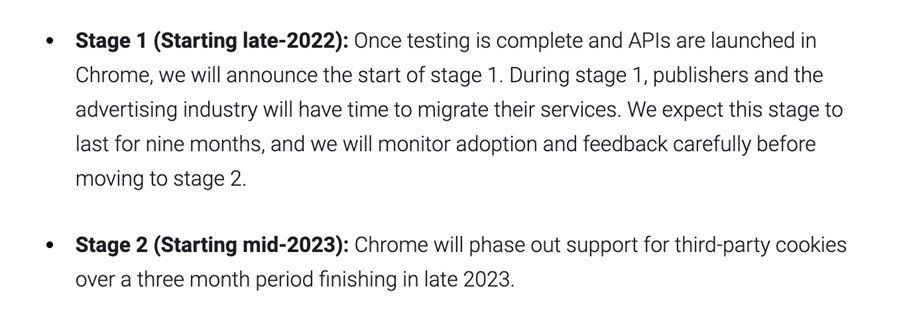5 Digital Marketing Trends That Could Change The Industry Forever
If you have any experience marketing for your business, then you may already be aware that using third-party data for the purpose of hyper-personalizing advertising campaigns was, at one point in time, one of the hottest digital marketing trends. The use of third-party data has helped businesses and publishers earn millions of dollars in revenue.
But now, let’s fast forward a few years – Google has announced the death of third-party cookies. Here’s how Google plans to phase out third-party cookies:

And while the phase-out process will kickstart starting mid-2023, advertisers and businesses across the globe majorly relying on third-party data have been forced to switch to alternate strategies.
This means – the use of third-party data, a strategy that was once one of the hottest digital marketing trends, is now something marketers, advertisers, and businesses are running away from. In short, we can conclude that the world of digital marketing is ever-changing.
And in this ever-changing competitive world, if you want your business to thrive and achieve success, it’s extremely important for you and your marketing department to keep themselves updated with the latest digital marketing trends.
That’s the reason we’re rolling out this blog post in today – as it’ll help you adopt the five hot digital marketing trends and incorporate them into your future marketing strategy for the best possible results.
5 Hot Digital Marketing Trends to Look Forward to in 2022
Following are the five trends we’ll be discussing throughout the blog post:
· The Dominance of Marketing Automation
· The Rise of Voice Search
· Focus on Enhanced Privacy
· The Start of Metaverse
· The Continuous Growth of Influencer Marketing
Let’s touch down on each of these trends one at a time.
1. The Dominance of Marketing Automation
The global marketing automation market has been predicted to cross the $6 billion mark by 2026. As of this writing, if the numbers are to be believed, over 51% of companies use marketing automation. Of the ones taping into its full force, nearly 63% of them have reported that they have successfully outperformed their competitors.
That’s exciting. You don’t need to hire additional staff or spend your extra hours on sending a “Welcome Email” to every new customer that signs up on your website or opts for your free trial.
Marketing automation is a world full of endless possibilities. Imagine being able to send different emails to different sets of prospects/customers at different stages of their buyers’ journeys.
Tracking them individually and rolling out emails manually will consume a huge chunk of you and your staff members’ time. But – with marketing automation, you can set triggers and use different platforms and software to fulfill the purpose. [Need help managing these automations? Get in touch.]
We’re witnessing an ever-increasing number of businesses benefiting from marketing automation. Some of the most common examples (use-cases) include:
· Sending Welcome Emails
· Publishing on Social Media Platforms
· Rolling Out Strategic Newsletters or Emails
· Customer Onboarding
· Sending Transactional Message & Updates
· Reminding Cart Abandoners
· And much more!
2. The Rise of Voice Search
These days, it’s common for people to say, “What’s the weather like today?” to their smart speakers. By the end of this year, about 55% of households will reportedly own a smart speaker. The global smart speaker market value has been predicted to reach $15.6 billion by 2025, up from $7.1 billion in 2020.
You’ll be shocked to know that some people treat their smart assistants as their own family members.
Own an iPhone and want to wake up at 6 A.M.?
“Siri – can you please wake me up at 6 A.M. tomorrow?”
That’s all you need to say.
Over 65% of smart speaker users have reported that they can’t imagine going back to the time when there were no smart speakers around. And with an ever-increasing number of people and wide usage of smart speakers, it makes sense for businesses to optimize their content for voice search.
That’s because the way we communicate with our smart speakers is different from how we type on Google. For example, if you are on the lookout for a good Chinese restaurant in New York, then here’s the difference.
Google Query – “best chinese restaurants in New York”
Voice Search – “Hey {Smart Assistant Name}, could you please show me the five best Chinese restaurants in New York?”
There’s a huge difference. Hence, it’s important for business owners to ensure that their website, as well as content, are voice search-friendly.
3. Focus on Enhanced Privacy
We talked about this in the introduction section. But – Google’s third-party cookie phase-out initiative isn’t the only privacy-driven measure being discussed in the marketing world. In 2021, Apple launched its privacy-focused features like App Tracking Transparency, Mail Privacy Protection, and more to protect user data.
About 86% of Americans have reported that they are extremely concerned about their online privacy and have tried eradicating or decreasing their online footprint at least once.
And despite regulations like GDPR, CCPA, and more, we’ve been witnessing tech giants like Facebook, Google, Apple, and many more tracking our day-to-day activities and using our data without consent.
These enhanced privacy measures have been making it harder for marketers, advertisers, and businesses to hyper-personalize their campaigns or track their consumer activity – which has resulted in many of their marketing and advertising campaigns failing.
But – it’s not the end. Marketers have always prevailed and learned to adapt in these types of situations. Just like how we adapted to take on the power social media marketing. So rest assured, we’ll figure something out.
4. The Start of Metaverse
Recently, we witnessed the milestone of Facebook changing its company name to Meta. If you haven’t heard already, be sure to watch Mark Zuckerberg introduce the concept of Metaverse in this ~10-minute-long video.
What is the Metaverse? Honestly, nobody really knows for sure. All we know is that it’s a virtual reality space where people can build their own avatars and interact with others in the virtual world – engage in fun activities, communicate, participate in contests and do much more.
With Metaverse being a fairly new yet revolutionary concept, metaverses like Decentraland and many more are flooded with Millennials & Gen-Z.
Brands don’t want to miss out – which is why we’ll see them market and advertise their products and services in these virtual worlds. Roblox, in 2021, announced the launch of Vans World – which is a highly interactive Vans metaverse playground.
For those who are not aware, Vans is one of the most popular shoe brands across the globe. This online park has been visited by more than 48 million people – which in itself is really impressive.
Brands have already begun their marketing and advertising efforts across different metaverses. And in 2022 and beyond, we’ll see this trend continue.
5. The Continuous Growth of Influencer Marketing
Data fetched from Statista indicates that influencer marketing's global market value stood at $13.8 billion in 2021. And if you think we are at the peak, we’re just getting started. Influencer marketing has been predicted to cross new heights – with an ever-increasing number of businesses investing thousands or millions of dollars each in reaching out to and collaborating with influencers to promote their products and services.
For every single dollar, you spend on influencer marketing, you may expect an average ROI of $6.5. That’s huge.
And while influencer marketing has become quite common, we’re seeing brands switching to nano and micro-influencers to run strategic campaigns at a budget-friendly price.
If you haven’t yet begun tapping into the power of influencer marketing, you’re missing out a huge opportunity to grow your business.
Conclusion
As we mentioned above, the world of digital marketing is constantly changing. And it’s crucial for businesses like yours to stay up to date with the latest trends. Make sure that you are implementing new strategies into your campaigns and ask yourself, is your business prepared for the future?
Keep up with the latest trends.
You might also like





